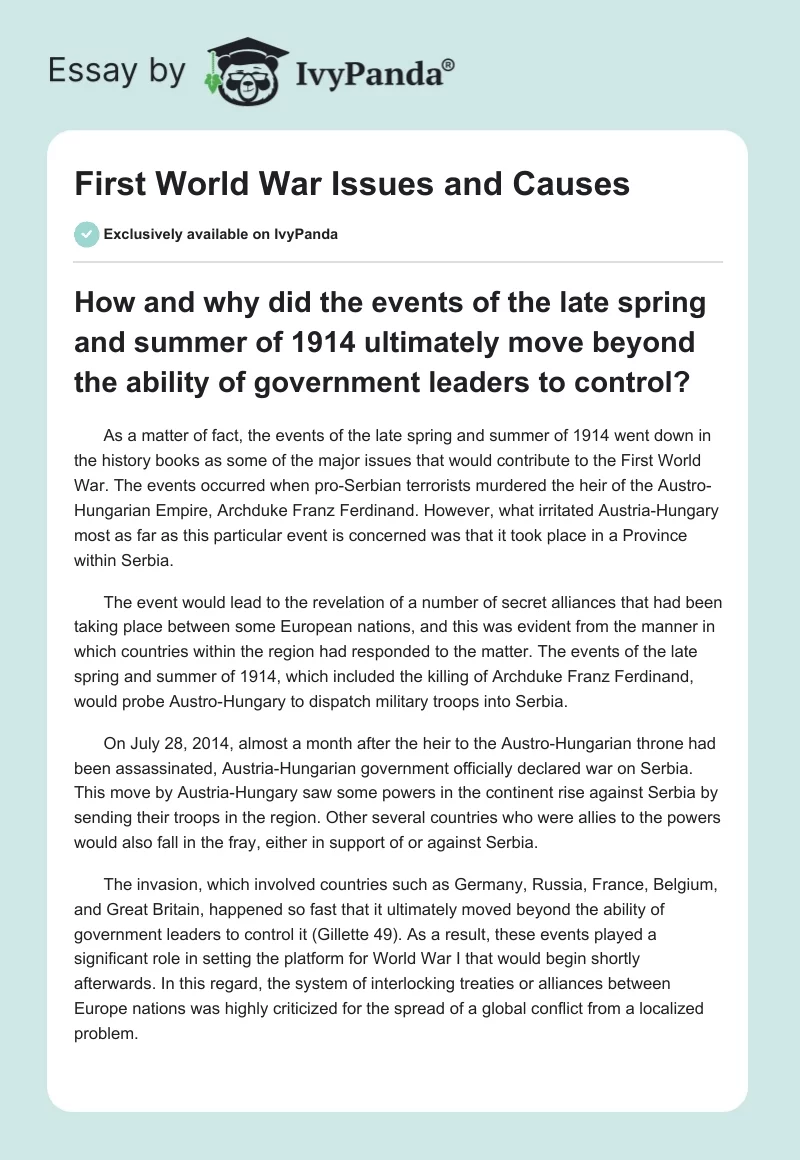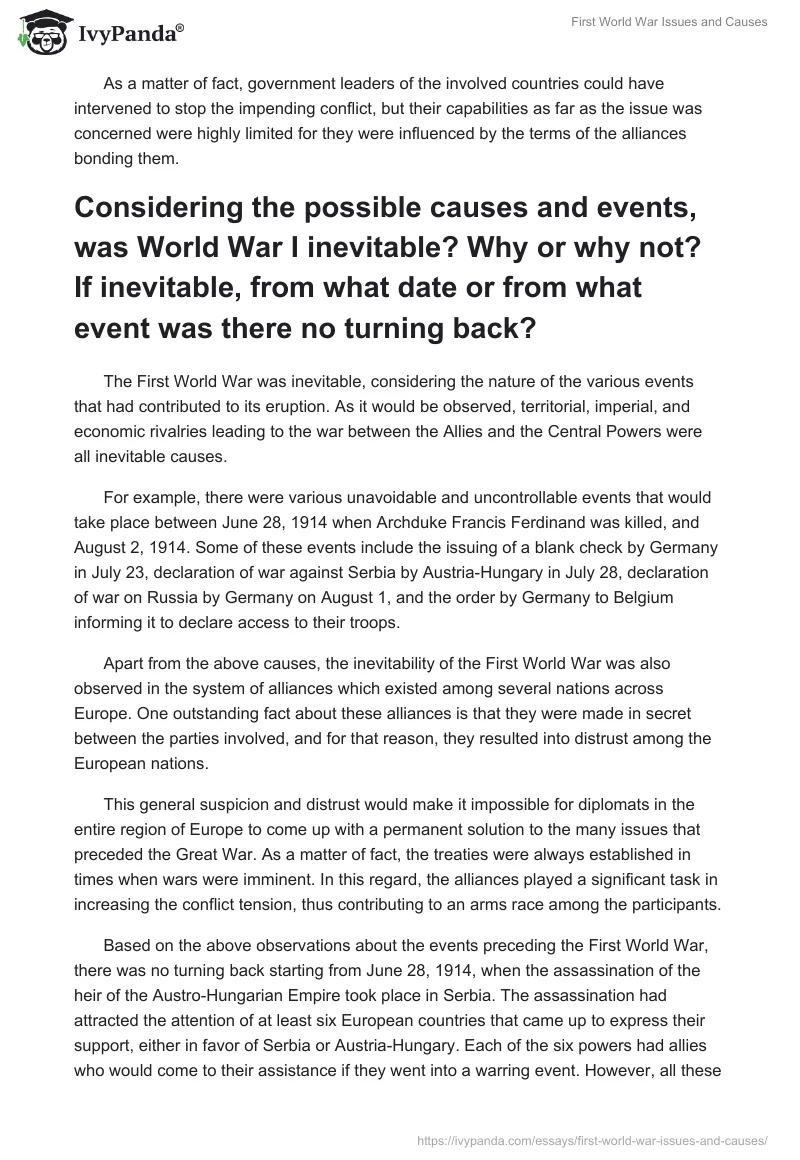How the World Went to War in 1914
As a matter of fact, the events of the late spring and summer of 1914 went down in the history books as some of the major issues that would contribute to the First World War. The events occurred when pro-Serbian terrorists murdered the heir of the Austro-Hungarian Empire, Archduke Franz Ferdinand. However, what irritated Austria-Hungary most as far as this particular event is concerned was that it took place in a Province within Serbia.
The event would lead to the revelation of a number of secret alliances that had been taking place between some European nations, and this was evident from the manner in which countries within the region had responded to the matter. The events of the late spring and summer of 1914, which included the killing of Archduke Franz Ferdinand, would probe Austro-Hungary to dispatch military troops into Serbia.
On July 28, 2014, almost a month after the heir to the Austro-Hungarian throne had been assassinated, Austria-Hungarian government officially declared war on Serbia. This move by Austria-Hungary saw some powers in the continent rise against Serbia by sending their troops in the region. Other several countries who were allies to the powers would also fall in the fray, either in support of or against Serbia.
The invasion, which involved countries such as Germany, Russia, France, Belgium, and Great Britain, happened so fast that it ultimately moved beyond the ability of government leaders to control it (Gillette 49). As a result, these events played a significant role in setting the platform for World War I that would begin shortly afterwards. In this regard, the system of interlocking treaties or alliances between Europe nations was highly criticized for the spread of a global conflict from a localized problem.
As a matter of fact, government leaders of the involved countries could have intervened to stop the impending conflict, but their capabilities as far as the issue was concerned were highly limited for they were influenced by the terms of the alliances bonding them.
Was World War I Inevitable?
The First World War was inevitable, considering the nature of the various events that had contributed to its eruption. As it would be observed, territorial, imperial, and economic rivalries leading to the war between the Allies and the Central Powers were all inevitable causes.
For example, there were various unavoidable and uncontrollable events that would take place between June 28, 1914 when Archduke Francis Ferdinand was killed, and August 2, 1914. Some of these events include the issuing of a blank check by Germany in July 23, declaration of war against Serbia by Austria-Hungary in July 28, declaration of war on Russia by Germany on August 1, and the order by Germany to Belgium informing it to declare access to their troops.
Apart from the above causes, the inevitability of the First World War was also observed in the system of alliances which existed among several nations across Europe. One outstanding fact about these alliances is that they were made in secret between the parties involved, and for that reason, they resulted into distrust among the European nations.
This general suspicion and distrust would make it impossible for diplomats in the entire region of Europe to come up with a permanent solution to the many issues that preceded the Great War. As a matter of fact, the treaties were always established in times when wars were imminent. In this regard, the alliances played a significant task in increasing the conflict tension, thus contributing to an arms race among the participants.
Based on the above observations about the events preceding the First World War, there was no turning back starting from June 28, 1914, when the assassination of the heir of the Austro-Hungarian Empire took place in Serbia. The assassination had attracted the attention of at least six European countries that came up to express their support, either in favor of Serbia or Austria-Hungary. Each of the six powers had allies who would come to their assistance if they went into a warring event. However, all these participants harbored economic, imperialistic, and territorial tensions that were building up among themselves, thus necessitating the Great War.
Developments During the War
Some of the biggest developments that were observed as the First World War unfurled include the trench warfare and the role of women in the war effort.
Trench Warfare
This refers to the kind of fighting techniques that were used in the course of the War. As the war advanced, soldiers aligned to the Triple Entente and the Triple Alliance adopted the practice of digging trenches that would protect them from their enemies. Trenches for opposing sides were secured using barbed wire and landmines that were buried beneath the soil.
The trenches usually had a depth of 2 meters and their wall surroundings were reinforced using dirt. The trenches were usually laid out in a zig zag pattern to ensure that soldiers were protected from missiles targeting the holes. The area separating the trenches of two opposing sides in a battlefield was referred to as a no man’s region. This area was usually a dangerous ground to trend on, since it separated two conflicting sides.
Life in the trenches was a bit harsh for the soldiers, considering the many unfavorable conditions that were associated with the holes, especially during rainy seasons. Moreover, there were no latrine or waste disposal zones and this made life more miserable for the warriors.
All this conditions made fighting in the underground holes hardly pleasant work for the soldiers. Apart from making life unpleasant, the trenches facilitated the spread of deadly diseases such as dysentery, trench foot, measles, trench influenza, and typhus among the fighters and their families.
The Role of Women in the War
The Great War brought great changes to every aspect of human life, including to the roles that were played by women in the society. While some women would adopt a strong anti-war position, others, especially those who came from the warring zones, threw their patriotic weight behind their male counterparts.
As it would be observed, females made major contributions to the war effort in a number of ways (Braybon 75). For instance, they took over men’s roles in arsenals, firearm factories, and government dockyards where they assisted in ensuring that ammunition and other war materials were safely delivered to soldiers in various parts of the world. Based on these facts, the contribution of women to the war effort cannot be overestimated.
What Finally Brought This War to an End?
The First World War would go on for four consecutive years, before coming to an end in November 1918. Apart from causing unprecedented damage across the world, this global conflict also claimed more than 10 millions lives worldwide. The Great War was finally terminated when Germany and the Allied powers completed negotiations on the terms of peace by putting their signatures on the Treaty of Versailles.
The Germans had become weak in the war following the diminishing support of their ailing supporters and exhaustion of war resources, among other reasons. The Germans could not bear the circumstances any longer, and were therefore forced to seek armistice with the Allies in November, 1918.
Works Cited
Braybon, Gail. Women Workers in the First World War, United Kingdom: Routledge, 2012. Print.
Gillette, Aaron. “Why Did They Fight the Great War? A Multi-Level Class Analysis of the Causes of the First World War.” The History Teacher 40. 1 (2006): 45-58. Print.


